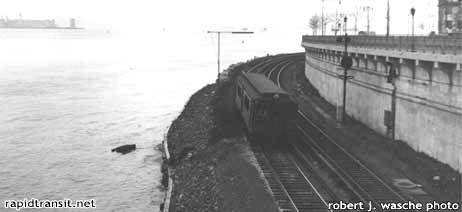
Page 12

The Tottenville Line won a reprieve when Board of Transportation president Sidney Bingham surprisingly agreed to a Public Service Commission proposal to have the City’s Staten Island buses serve as feeders.
The SIRT on the Edge
In July 1953 the New York City Transit Authority succeeded the Board of Transportation. Whether the Staten Island feeder system was lost in the shuffle or no suitable agreement could be reached, there was no change in the status quo.
The SIRT once again threatened to close down the Tottenville Line in the late summer of 1954. The Public Service Commission warned that, if the SIRT did so, action would be taken to oust the parent B&O from Staten Island, which would have meant the loss of a prospering freight operation. Tottenville service was maintained, but with a sizable city subsidy.
The SIRT sold 30 of its Standard Steel cars to the Transit Authority in 1953-4 as the single Tottenville Line did not require the equipment.
Bus Competition and
Falling Revenues
In 1948 the New York City Board of Transportation, which had gained all but complete control over transit in the other four boroughs (with the exception of certain surface lines), took over the Staten Island bus routes. It immediately cut the fares to the level of other City lines, eliminated zone-fares, and introduced a 12-cent combination fare with transfer that allowed a rider to take the bus to St. George and a subway from South Ferry and vice versa. By the end of 1949 the railway lost 60% of the fares it had in 1947, the year before the City takeover.
A huge cutback in service, mainly in off-hours, did not help much and in 1950 the railway proposed to sell the passenger operations to the City in return for various freight considerations. No action was taken.
Finally, in 1953, the SIRT announced its intention of ending passenger service on all three lines. Ridership was not good on the Tottenville Line, and single-car trains served South Beach and Arlington. The latter two lines did close on March 31st.

North Shore Branch. Before passenger service ended in 1953, single cars covered most of the runs on the line from St. George to Arlington. Above: a car hugs the shoreline between the street embankment and Upper New York Harbor near New Brighton. Below: looking like a pole-less interurban, a train at Arlington awaits its return run.

Updated
©1965 Silver Leaf Rapid Transit. ©2001 Paul Matus. ©2001 The Composing Stack Inc.